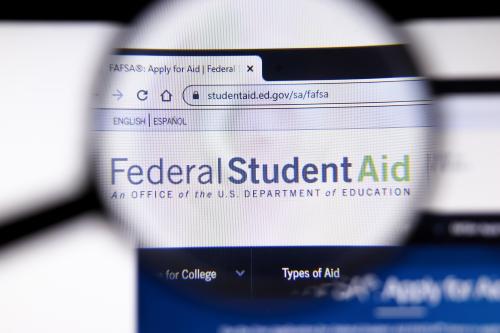Discussions about the rising cost of college routinely miss the point. At four-year public and private institutions, the total cost of attendance almost tripled between 1979-80 and 2020-21, accounting for inflation. But only students from higher-income families pay that full cost, or “sticker price,” featured in headlines. Most students pay less because they receive financial aid in the form of grants (sometimes called scholarships). This means they pay a “net price” that is less—often much less—than the sticker price. Determining the net price for individual students is difficult, and tracking changes over time is even harder. But if we want to understand changes in college affordability, we need to track not only the highly visible sticker prices but also financial aid and net prices.
While the net price is what’s relevant for understanding college affordability, unfortunately it is not as easy as it should be to find reliable information on net prices and how they have changed over time. To help fill this void, I have been collecting better net price data for selected colleges.
These data confirm that lower- and middle-income students pay a net price that is typically much less than the sticker price. And net prices have actually been falling, on average, in recent years, not rising. But the data also show that the net price many lower-income students must pay is still too high at most institutions. This lack of college affordability for lower-income students, not the dramatic rise in sticker prices which only higher-income students pay, is what should capture our attention.
Net prices have actually been falling, on average, in recent years, not rising.
There are several steps that should be taken to address these problems. First, we need better information regarding college costs that are specific to individuals’ financial circumstances. The focus on sticker prices is perhaps understandable since institutions are required by law to report it annually. Net prices are specific to the individual, and generating that information is difficult. Finding better ways to report and track net price is sorely needed. Re-labelling the sticker price as the “maximum cost of attendance” is an easy first step to help clarify misperceptions regarding college pricing. To reduce the net price for lower-income students, increasing the maximum size of Pell Grants (the largest form of federal financial aid that does not need to be repaid) would go a long way towards fixing that problem.
Sticker prices are misleading and net prices are hard to find
A college education is one of the biggest expenses individuals face during their lives. College is not necessarily right for everyone, but the decision about whether and where to attend college should be based on accurate pricing information. What a student needs to know is not how much college costs in general but how much it will cost them. For most students the sticker price is misleading. Averages are not that informative either since the net price depends on individual circumstances.
Similarly, if policymakers, advocates, and commentators want to understand trends in college affordability over time for different types of students, they need to track net prices, not sticker prices. Almost a decade ago, I wrote about how difficult it is to determine how much colleges charge students with different financial circumstances. In terms of publicly available data, not much has changed since then. Figuring out how much a student can expect to pay to attend different colleges is still too difficult.
The federal government requires higher education institutions to post their “cost of attendance (COA),” an amount sometimes referred to as the “sticker price” that includes tuition, fees, room and board (soon to be relabeled as housing and food), travel, books, and other expenses. But most students pay less than that because they get financial aid. The “net price” is the sticker price minus the total grant aid a student receives (grant aid does not have to be paid back). Many students will qualify for federal student loans and the work-study program, which they can use to cover the net price they are expected to pay.
Any remaining amount not covered by grants, federal student loans, and work-study earnings must be paid for separately by students and their families. These remaining expenses are often referred to as “out-of-pocket” costs because they need to be paid by students and their families directly to the institution (i.e., by “writing a check,” back in the day before electronic payment systems). The funds to cover those payments could come from many sources, including savings or other sources of debt (including “Parent PLUS” loans), but out-of-pocket costs represent the additional burden on students and families that are not otherwise accounted for by the financial aid system.
Recognizing the need for more accurate information about how much students can expect to pay for college, the 2008 Higher Education Opportunity Act mandated that institutions provide a tool that students could use to estimate their net price based on their personal financial circumstances; these tools are known as “net price calculators.” The law also requires institutions to report statistics on the net price paid by their students, overall and separately for specific income ranges.1 These data are reported on the College Scorecard.
Unfortunately, neither of these data sources has fully solved the problem. Net price calculators do not get the job done. They are often difficult to use and sometimes difficult even to find (which is consistent with my own experience using hundreds of net price calculators multiple times). Net price calculators are a well-intended step in the right direction, but they still have a long way to go. The net price data available at the College Scorecard also fall short. They can give a student some sense of what they might pay, but they do not fully incorporate individual circumstances and some of the data appear to be inaccurate or misleading.2
Department of Education data show average net prices increase more slowly than sticker prices and have declined recently
Despite the limitations of the publicly available data, they do provide some useful information on trends in college pricing. For example, Figure 1 shows trends in the average COA and average net price (adjusted for inflation) since 2006-07, separately for public and non-profit private four-year institutions.
Between 2006-07 and 2019-20, COA increased by around 27% at both types of institutions, but declined by 7-8% in the few years after that. The recent decline occurred because colleges posted similar nominal COA increases as in the past, but inflation was higher. Overall, COA increased by almost 20% over those 16 years at both types of institutions.
But average net prices rose at a considerably more modest pace. Between 2006-07 and 2019-20, average net price increased by 13% and 7% at public and private four-year institutions, respectively. Those increases reversed in the post-COVID years. Overall, average net prices are largely unchanged, adjusted for inflation, compared to 2006-07.
But the average net price for all students reported here includes both those who receive financial aid and those who pay full price. Since those who pay full price faced higher prices over time, net prices among those who receive financial aid must have fallen. Without additional information, we cannot say more about how net price changed for different types of students, but the fact that net price is falling for students who receive financial aid is important and not consistent with public perception.

New data for tracking college pricing
Over the past decade, I have focused on finding ways to construct data that better communicate the level and trend in college costs for students with different financial circumstances. These data cover a more limited set of institutions and time periods than the Department of Education data described above, but they provide a more consistent and accurate picture of changes in net price over time.
I have taken two approaches. First, I draw on detailed data from institutions and the MyinTuition model I developed to track net prices for institutions who agree to participate. The second approach uses the net price calculators described above to track net prices at a random sample of institutions. In both cases, I track net prices for hypothetical dependent students with no siblings in college for three different family income levels (in 2022$): $40,000, $75,000, and $125,000. These incomes correspond roughly to the 25th, 50th, and 75th percentile of the income distribution for families with college-aged children.3 To estimate net prices, I also assume typical asset levels, adjusted for inflation, at each income level.
Consistent with the average net price data described above, these new data sources show declining net price for lower-income students in recent years. They also highlight ongoing problems with the levels of net prices for many students. Across the board, low- and moderate-income families pay net prices that are well below the posted sticker price; but in many cases, the net prices for these families are still too high. Notably, highly selective private colleges with large endowments have some of the highest sticker prices but the lowest net prices for low-income students.
Net prices at MyinTuition institutions have declined substantially
Almost a decade ago, I wrote about the work I did at Wellesley College to create a simplified tool to estimate college costs based on families’ basic financial characteristics.4 That led to the creation of MyinTuition, which provides estimates of what a students’ financial aid award might look like based on data on current students whose families had similar financial characteristics. MyinTuition provides both a best estimate and a 90% confidence interval to convey the uncertainty about the estimate.
MyinTuition uses institution-specific data for each student receiving need-based financial aid to generate its predictions. These data are higher quality than that available from any public source, but they are only available for participating institutions. For this analysis, I focus on 14 of the 78 participating institutions for whom my data extends back to 2015-16.5 They are all highly selective private non-profit colleges and universities that have large endowments (they would fall in the “private, non-profit, large endowment” category in the analysis described below).
Figure 2 shows trends in the net price for dependent students with no siblings in college at different levels of family income (assuming typical assets and adjusted for inflation). These data are based on MyinTuition’s best estimate of net price for these students in each year. Students from middle- and lower-income families now pay less to attend these institutions than they did seven years ago. The trend began before the COVID-19 pandemic and has accelerated since then. At the same time, sticker prices (i.e., COA) initially increased and then reversed, ending the period at roughly the same level as they started.

Figure 2 also demonstrates how the level of sticker price can skew perceptions of college costs. These institutions have among the highest sticker prices in the country—around $80,000 in 2022-2023. This amount is clearly unaffordable for all but high-income families. But those are the only students who are asked to pay that amount. Students with incomes around $40,000 (roughly the bottom quartile of the income distribution) pay a net price of $5,000 on average at these institutions. They could cover that amount through Federal student loans, work study wages, or perhaps a summer job, so families would have to pay little or nothing out-of-pocket in this situation (though the student would have to pay back any student loans with interest).
These institutions can use these pricing strategies because of their large endowments and market power. Their endowments generate revenue through investment returns that help subsidize students. Their market power enables them to charge high sticker prices to high-income students, which also helps subsidize attendance of lower-income students. This is not a pricing strategy that most institutions can pursue.
Net price calculators also show that prices are down across sectors
Despite their flaws, data from net price calculators can also be used to understand college pricing. Generating these data requires physical entry of relevant values into each net price calculator, including different income and asset levels in each one.6 My research team and I undertook this time-consuming analysis, collecting data for 200 randomly selected institutions, 50 from each of four categories: (1) private, non-profit colleges with large endowments, (2) other private, non-profit colleges, (3) public flagship and other “R1” institutions (four-year colleges with significant research activity), and (4) other public institutions.7 I focus here on the change between 2018-19 and 2022-23.
The results shown in Figure 3 shows the inflation-adjusted percent change in net price for the four types of institutions and at the three levels of family income, as well as the full COA. COA fell 5-10% across all types of institutions, with the largest decline among public flagships/R1s. Net prices fell even more: In all institution types, aside from other public institutions, net prices declined by about 10-15%. Net prices at other public institutions also declined but somewhat less, by about 5-10%.

Declining net prices are good news for students and their families, but these data also point to ongoing affordability problems for lower-income students. Table 1 shows the levels of net price for students by family income level for 2018-19 and 2022. For lower-income families with income around $40,000, public institutions still charge these students a net price of around $14,000 on average. That is around $1,000 less than what they charged 4 years ago. It is also much less than the sticker prices of roughly $25,000 to $30,000.
But net prices are still too much for these lower-income families to afford. Students in that income range would also be eligible for Federal Student Loans of $5,500 in each of their first two years in college and for employment supported by the Federal Work-Study Program, which typically amounts to about $2,500. These two additional forms of federal financial aid can contribute $8,000 towards the cost of college. That still leaves a gap of $6,000 that these students or their families would need to pay out of their own pockets. With a family income of $40,000 and limited assets, out-of-pocket payments of that size represent a substantial obstacle to college access.
Private institutions with large endowments come closer to filling the gap. Low-income students at those institutions would have out-of-pocket expenses of $2,700, around half the level at public institutions. Other private institutions, though, leave a gaping hole in affordability, with remaining expenses of around $13,000 that are clearly unaffordable for these students.

Why have college costs been falling recently?
Colleges and universities surely have social objectives, but they also face budget constraints and make pricing decisions in line with their business interests. What is changing in the market for higher education that is leading to these patterns in college pricing?
Inflation has played an important role. In the decade prior to the COVID-19 pandemic, sticker prices at four-year institutions increased about 3% per year, on average; that was about 1.5% above the average rate of inflation. In the post-COVID era, though, inflation increased, hitting 7% in 2021 and 6.5% in 2022. In a low-inflation environment, sticker price increases on the order of 3% may fly under the radar, even though they correspond to modest increases in inflation-adjusted terms. But sticker price increases greater than today’s much-higher rate of inflation would appear very large even if the real increase, after adjusting for inflation, was the same as before. To avoid public backlash, institutions mostly increased their sticker prices at rates comparable to earlier nominal increases. That led to the inflation-adjusted decline in sticker prices shown in the data above.
But that real decline in sticker prices reduces revenue to the institution that needs to be made up somehow to meet rapidly rising costs. One potential approach to filling that gap is to reduce financial aid, increasing the cost for lower-income students. The lack of transparency in the financial aid system would mask those cost increases.
Colleges do not appear to have taken that approach in the last few years. One possible explanation is that institutions had other sources of revenue that were able to fill those gaps. Stimulus funding provided by the federal government to states and to higher education institutions may have prevented colleges from reducing financial aid and/or increasing sticker prices to cover rising costs. It remains an open question how college pricing will respond now that those federal funds are no longer available.
The situation is somewhat different at highly selective institutions, which typically meet the full financial need of their students. This means that students and their families pay an amount out-of-pocket based on what a formula says they can afford (based on FAFSA and the CSS Profile, an additional financial aid application run by the College Board used by some colleges). Students are also often expected to take out some student loans and participate in work-study, but they will not be expected to contribute more out-of-pocket than the formula says they can afford.
Low- and moderate-income families pay net prices that are well below the posted sticker price; but in many cases, the net prices for these families are still too high.
Based on the MyinTuition data for 14 such colleges, net prices for lower- and middle-income students have fallen considerably since 2015-16. For families with incomes around $40,000, their net price has fallen by 23% after adjusting for inflation. For $75,000 and $125,000 income families, net price has fallen 22% and 14%, respectively. Much of that decline is driven by the fact that the expected work-study earnings and loans have been largely fixed in nominal dollars over that period, declining in real terms. At institutions that meet full need, declines in the real value of student loans or work-study earnings need to be matched by greater grant aid, not by increasing out-of-pocket cost. Greater grant aid drives down real net prices. Some of these institutions have also adopted more generous financial aid policies that have also contributed to this decline.
Pricing at most institutions that do not meet full need is more complicated. Families are often expected to pay out-of-pocket more than the formula says they can afford. How much more depends on institutional policy. Those institutions, though, also include work-study jobs and loans in their financial aid packages, which are part of how students are expected to cover their net price. Again, these values have largely been fixed in nominal dollars and contribute to falling net prices at these institutions.
Policy Implications
Despite the public focus on sticker prices, discussions regarding college pricing should emphasize college affordability for lower- and moderate-income students more. This means focusing on net prices, which, for low-income students, are much lower than sticker prices. Without diminishing the difficulties that higher-income students may face in paying for college, the struggles lower- and moderate-income students experience are considerably greater.
Elsewhere, I have argued for doubling the Pell Grant to help overcome this problem. In addition to more financial support for low-income students, we need to address the lack of transparency in college pricing. Data on trends in college pricing needs to better represent the costs that lower- and moderate-income students face. Without such data, students, families, and policymakers cannot easily recognize the magnitude and nature of the college affordability problem, and efforts to fix it are often misdirected.
Ironically, our recent bout with inflation has lowered net prices for college for all students. At highly selective institutions, that decline appears to have started earlier for all but higher-income students. It remains to be seen whether these trends continue, not just for sticker prices but for the net prices that lower- and moderate-income students face. If we do not find better ways to track college costs for students with different family financial circumstances, we will not easily know if that happened. Students and their families will continue to make one of the most important financial decisions of their lives half in the dark.
The Brookings Institution is financed through the support of a diverse array of foundations, corporations, governments, individuals, as well as an endowment. A list of donors can be found in our annual reports published online here. The findings, interpretations, and conclusions in this report are solely those of its author(s) and are not influenced by any donation.
-
Footnotes
- It is now possible to obtain institution-level data on the average net price paid by full-time, first-time degree/certificate-seeking undergraduate students who receive any form of federal financial aid (including student loans). These data have been available since 2006-07. In addition to the aggregate average net price, the law also required institutions to provide average net prices within a series of family income categories: less than $30,000, $30,000 to $48,000, $48,000 to $75,000, $75,000 to $110,000, and greater than $110,000 (approximate quintile cut-offs of family income at that time).
- These data suffer from several potential problems. First, financial aid is based on income and assets, which are not always directly linked. Second, use of the median would be a significant improvement because of the possibility of outliers. Third, income categories are fixed in nominal dollars. Over time, inflation has changed the composition of students in each category. My examination of these data from institutions whose pricing systems I know well (described below) revealed significant deviations between the reported level and trend in net prices by income level and what students could realistically expect to pay. These discrepancies are highlighted in the difference in net price trends reported in the media using these data and the results reported below using data that addresses these limitations.
- These cut-offs are rounded. They were established using the 2016 Survey of Consumer Finances for families with children approaching college age (between 13 and 17) and have been adjusted for inflation by the Consumer Price Index in subsequent years, arriving at these values in 2022.
- After developing the model at Wellesley College, I worked to expand the use of MyinTuition to more colleges and universities. In 2017, I started a non-profit corporation, MyinTuition Corp, severing its link (although not my own) to Wellesley College to avoid the appearance of any conflict of interest. For each institution using MyinTuition, I have access to a limited set of financial aid data, including all components needed to construct net prices for each aid recipient (with all appropriate security and privacy concerns contractually addressed). The data available to me are proprietary and cannot be shared.
- These institutions are Amherst College, Bowdoin College, Carleton College, Colorado College, Columbia University, Dartmouth College, Mount Holyoke College, Pomona College, Rice University, Vassar College, Washington and Lee University, Wellesley College, Wesleyan University, and Williams College.
- We use the same values of income and assets as described in our analysis of MyinTuition data. Along with income and assets, we also entered reasonable values of all other requested inputs. We first constructed these data for the 2018-19 academic year and repeated the same exercise for the 2021-22 and 2022-23 academic years.
- I define high endowment private institutions include those whose endowment per student is greater than $150,000 in 2017. This includes a broad range of institutions, including Wabash College, with a current endowment per student that is roughly one-tenth of the value at Princeton University. See my recent book for more detail.
The Brookings Institution is committed to quality, independence, and impact.
We are supported by a diverse array of funders. In line with our values and policies, each Brookings publication represents the sole views of its author(s).







